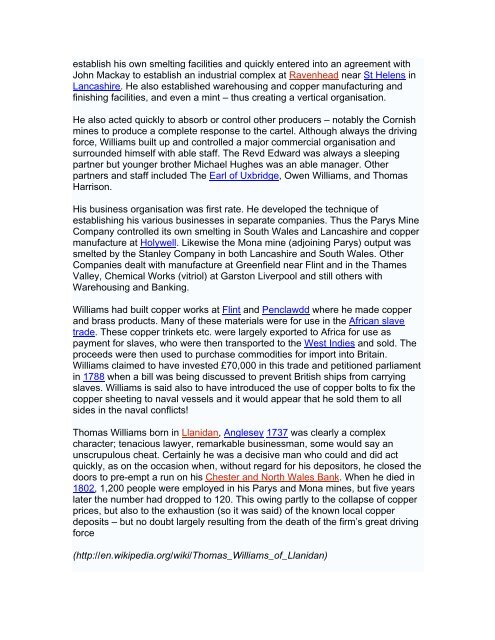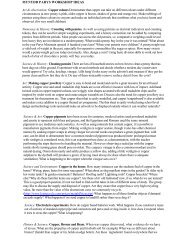Wales links with the slave trade ⢠By 1800 ... - Copper Kingdom
Wales links with the slave trade ⢠By 1800 ... - Copper Kingdom
Wales links with the slave trade ⢠By 1800 ... - Copper Kingdom
You also want an ePaper? Increase the reach of your titles
YUMPU automatically turns print PDFs into web optimized ePapers that Google loves.
establish his own smelting facilities and quickly entered into an agreement <strong>with</strong><br />
John Mackay to establish an industrial complex at Ravenhead near St Helens in<br />
Lancashire. He also established warehousing and copper manufacturing and<br />
finishing facilities, and even a mint – thus creating a vertical organisation.<br />
He also acted quickly to absorb or control o<strong>the</strong>r producers – notably <strong>the</strong> Cornish<br />
mines to produce a complete response to <strong>the</strong> cartel. Although always <strong>the</strong> driving<br />
force, Williams built up and controlled a major commercial organisation and<br />
surrounded himself <strong>with</strong> able staff. The Revd Edward was always a sleeping<br />
partner but younger bro<strong>the</strong>r Michael Hughes was an able manager. O<strong>the</strong>r<br />
partners and staff included The Earl of Uxbridge, Owen Williams, and Thomas<br />
Harrison.<br />
His business organisation was first rate. He developed <strong>the</strong> technique of<br />
establishing his various businesses in separate companies. Thus <strong>the</strong> Parys Mine<br />
Company controlled its own smelting in South <strong>Wales</strong> and Lancashire and copper<br />
manufacture at Holywell. Likewise <strong>the</strong> Mona mine (adjoining Parys) output was<br />
smelted by <strong>the</strong> Stanley Company in both Lancashire and South <strong>Wales</strong>. O<strong>the</strong>r<br />
Companies dealt <strong>with</strong> manufacture at Greenfield near Flint and in <strong>the</strong> Thames<br />
Valley, Chemical Works (vitriol) at Garston Liverpool and still o<strong>the</strong>rs <strong>with</strong><br />
Warehousing and Banking.<br />
Williams had built copper works at Flint and Penclawdd where he made copper<br />
and brass products. Many of <strong>the</strong>se materials were for use in <strong>the</strong> African <strong>slave</strong><br />
<strong>trade</strong>. These copper trinkets etc. were largely exported to Africa for use as<br />
payment for <strong>slave</strong>s, who were <strong>the</strong>n transported to <strong>the</strong> West Indies and sold. The<br />
proceeds were <strong>the</strong>n used to purchase commodities for import into Britain.<br />
Williams claimed to have invested £70,000 in this <strong>trade</strong> and petitioned parliament<br />
in 1788 when a bill was being discussed to prevent British ships from carrying<br />
<strong>slave</strong>s. Williams is said also to have introduced <strong>the</strong> use of copper bolts to fix <strong>the</strong><br />
copper sheeting to naval vessels and it would appear that he sold <strong>the</strong>m to all<br />
sides in <strong>the</strong> naval conflicts!<br />
Thomas Williams born in Llanidan, Anglesey 1737 was clearly a complex<br />
character; tenacious lawyer, remarkable businessman, some would say an<br />
unscrupulous cheat. Certainly he was a decisive man who could and did act<br />
quickly, as on <strong>the</strong> occasion when, <strong>with</strong>out regard for his depositors, he closed <strong>the</strong><br />
doors to pre-empt a run on his Chester and North <strong>Wales</strong> Bank. When he died in<br />
1802, 1,200 people were employed in his Parys and Mona mines, but five years<br />
later <strong>the</strong> number had dropped to 120. This owing partly to <strong>the</strong> collapse of copper<br />
prices, but also to <strong>the</strong> exhaustion (so it was said) of <strong>the</strong> known local copper<br />
deposits – but no doubt largely resulting from <strong>the</strong> death of <strong>the</strong> firm’s great driving<br />
force<br />
(http://en.wikipedia.org/wiki/Thomas_Williams_of_Llanidan)





